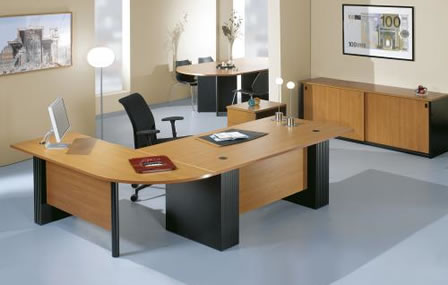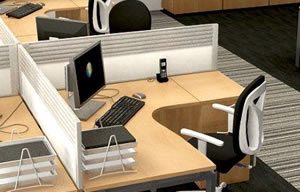How should you partition your office? If you're struggling to find the perfect office layout for your company, look no further!
We will guide you through the process of partitioning your office in a way that meets your company's needs and goals. Stay tuned as we delve deeper into each aspect mentioned above to help you make informed decisions about how you should partition your office!

Assessing Your Company's Needs and Goals
When determining how to partition your office, it's crucial to consider factors such as the size of your team and the nature of their work. Ask yourself, how should you partition your office based on the number of employees you have and how much office space per person is necessary for them to perform their tasks efficiently?
One important consideration is the level of collaboration required amongst your employees. If teamwork is a fundamental aspect of your company culture, an open floor plan with shared workstations or communal spaces may be more suitable. This layout promotes communication and fosters a sense of camaraderie among colleagues.
Ultimately, understanding how much office space per person is needed and aligning it with your company's specific needs will help guide you in making informed decisions about partitioning your office.
Free-standing screens are useful to separate different sectors within the office. Grouping desks in this way creates more of a team atmosphere with smaller enclosed areas within the larger office environment.

Determining the Type of Workspaces Required
Consider identifying the specific types of workspaces needed to optimise productivity and collaboration in your office. Start by assessing the different tasks and projects that your employees regularly engage in.
Think about creating dedicated areas for group discussions, brainstorming sessions, and meetings. These could include conference rooms equipped with technology such as video conferencing tools and whiteboards.
By providing these specific spaces designed for collaboration, you can encourage effective communication among team members and enhance innovation within your organisation.
Considering Privacy and Noise Control
When designing your office layout, it's crucial to think about creating designated areas that provide privacy and control noise levels.
Privacy is important in an office setting as it allows employees to focus on their work without distractions. Consider incorporating private offices or cubicles for tasks that require concentration, such as writing reports or analysing data. These enclosed spaces can be equipped with soundproof walls or partitions to minimise noise disruption from surrounding areas.
In addition to privacy, controlling noise levels is essential for a productive work environment. Open-plan offices can be designed with different zones based on noise levels required for specific tasks. For instance, a collaborative zone can have lower or no partitions to encourage communication and idea-sharing among team members. On the other hand, quiet zones can have higher partitions or separate rooms where individuals can retreat for focused work.
Providing designated areas for different noise levels will help create a balanced workspace that accommodates both collaboration and individual concentration needs.
Designing for Collaboration and Communication
Creating a collaborative and communicative workspace fosters innovation, builds strong teams, and drives productivity. When designing your office partitions with collaboration and communication in mind, consider the following:
1. Open concept spaces: Creating open areas without physical barriers encourages spontaneous interactions among employees. This layout allows for easy communication, idea-sharing, and collaboration.
2. Meeting rooms: Dedicated meeting rooms are essential for focused discussions and brainstorming sessions. These private spaces provide the opportunity for teams to come together and collaborate on projects without distractions.
3. Breakout zones: Incorporating designated breakout zones within your office partitions offers a relaxed environment for informal meetings or impromptu collaborations. These areas can be furnished with comfortable seating options to promote teamwork away from individual workstations.
By incorporating these elements into your office partition design, you create an environment that encourages collaboration, enhances communication, and ultimately boosts productivity within your organisation.
Creating an Aesthetic and Functional Office Layout
To optimise your office space, prioritise creating an aesthetic and functional layout that enhances productivity and fosters a sense of professionalism. Start by considering the overall design and flow of the space. Choose furniture and decor that not only looks good but also serves a purpose.
For example, opt for ergonomic chairs and adjustable desks to promote comfort and reduce the risk of musculoskeletal issues. Additionally, ensure that there's ample storage space to keep clutter at bay and maintain a clean and organised environment.
Next, think about how you can utilise partitions or dividers to create separate areas within the office. These partitions can provide privacy for individual workspaces while still allowing for collaboration when needed. Consider using glass or translucent materials for these dividers to maintain an open feel and allow natural light to trickle in throughout the space.
Strategic placement of these partitions can also help to define different zones within the office, such as meeting areas, quiet spaces for focused work, or communal spaces for informal discussions.
By focusing on aesthetics and functionality in your office layout, you can create a workspace that looks appealing and supports productivity and professionalism. Remember to choose furniture that prioritises comfort and invest in adequate storage solutions to keep clutter under control.
With a well-designed office layout, you can cultivate an environment that promotes efficiency and fosters a positive working atmosphere.
So, How Should You Partition Your Office?
When it comes to finding the ideal desk size for your workspace, there are several factors to consider. The importance of desk size in productivity can't be underestimated, as it directly affects your comfort and ability to work efficiently.
Ultimately, the right desk size depends on your preference and work style. You can find the perfect desk size that suits your needs and preferences by carefully weighing these factors and considering what will best support your productivity and well-being.
If you require assistance with your office design and finding desks that are the right size for your space, don't hesitate to get in touch with the expert team at Gazelle Office Furniture. We are here and ready to help you discover an effective solution for your office needs.
